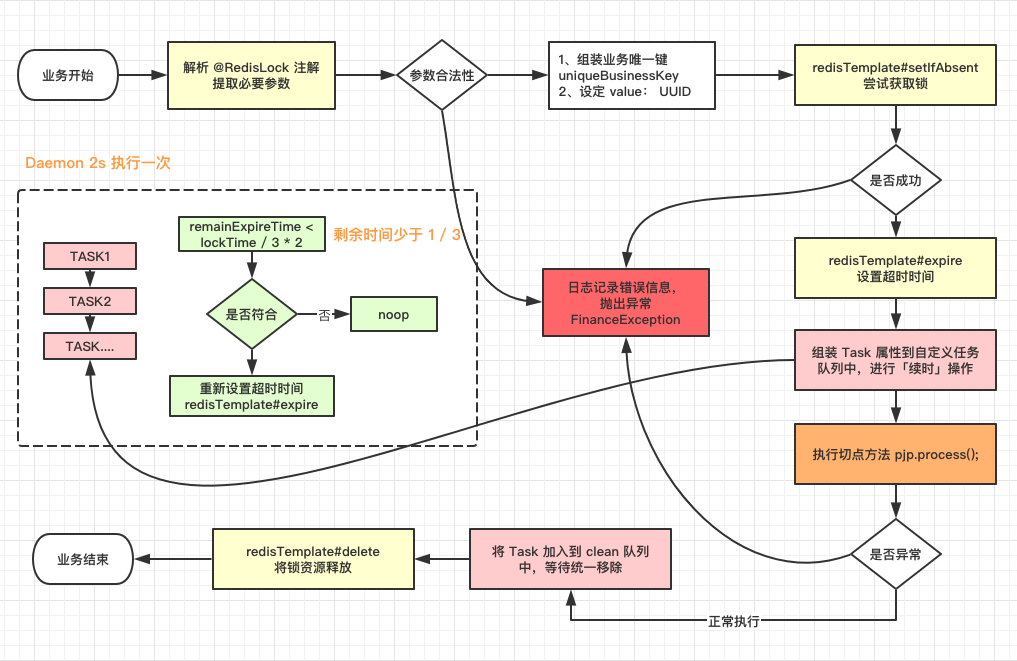

如何使用注解实现redis分布式锁!
嵌入式技术
描述
一、业务背景
有些业务请求,属于耗时操作,需要加锁,防止后续的并发操作,同时对数据库的数据进行操作,需要避免对之前的业务造成影响。
二、分析流程
使用 Redis 作为分布式锁,将锁的状态放到 Redis 统一维护,解决集群中单机 JVM 信息不互通的问题,规定操作顺序,保护用户的数据正确。
梳理设计流程
1、新建注解 @interface,在注解里设定入参标志
2、增加 AOP 切点,扫描特定注解
3、建立 @Aspect 切面任务,注册 bean 和拦截特定方法
4、特定方法参数 ProceedingJoinPoint,对方法 pjp.proceed() 前后进行拦截
5、切点前进行加锁,任务执行后进行删除 key
核心步骤:加锁、解锁和续时
加锁
使用了 RedisTemplate 的 opsForValue.setIfAbsent 方法,判断是否有 key,设定一个随机数 UUID.random().toString,生成一个随机数作为 value。
从 redis 中获取锁之后,对 key 设定 expire 失效时间,到期后自动释放锁。
按照这种设计,只有第一个成功设定 Key 的请求,才能进行后续的数据操作,后续其它请求由于无法获得资源,将会失败结束。
超时问题
担心 pjp.proceed() 切点执行的方法太耗时,导致 Redis 中的 key 由于超时提前释放了。
例如,线程 A 先获取锁,proceed 方法耗时,超过了锁超时时间,到期释放了锁,这时另一个线程 B 成功获取 Redis 锁,两个线程同时对同一批数据进行操作,导致数据不准确。
解决方案:增加一个「续时」
任务不完成,锁不释放:
维护了一个定时线程池 ScheduledExecutorService,每隔 2s 去扫描加入队列中的 Task,判断是否失效时间是否快到了,公式为:【失效时间】<= 【当前时间】+【失效间隔(三分之一超时)】
/**
* 线程池,每个 JVM 使用一个线程去维护 keyAliveTime,定时执行 runnable
*/
private static final ScheduledExecutorService SCHEDULER =
new ScheduledThreadPoolExecutor(1,
new BasicThreadFactory.Builder().namingPattern("redisLock-schedule-pool").daemon(true).build());
static {
SCHEDULER.scheduleAtFixedRate(() -> {
// do something to extend time
}, 0, 2, TimeUnit.SECONDS);
}
三、设计方案
经过上面的分析,设计出了这个方案:

前面已经说了整体流程,这里强调一下几个核心步骤:
拦截注解 @RedisLock,获取必要的参数
加锁操作
续时操作
结束业务,释放锁
四、实操
之前也有整理过 AOP 使用方法,可以参考一下
相关属性类配置
业务属性枚举设定
public enum RedisLockTypeEnum {
/**
* 自定义 key 前缀
*/
ONE("Business1", "Test1"),
TWO("Business2", "Test2");
private String code;
private String desc;
RedisLockTypeEnum(String code, String desc) {
this.code = code;
this.desc = desc;
}
public String getCode() {
return code;
}
public String getDesc() {
return desc;
}
public String getUniqueKey(String key) {
return String.format("%s:%s", this.getCode(), key);
}
}
任务队列保存参数
public class RedisLockDefinitionHolder {
/**
* 业务唯一 key
*/
private String businessKey;
/**
* 加锁时间 (秒 s)
*/
private Long lockTime;
/**
* 上次更新时间(ms)
*/
private Long lastModifyTime;
/**
* 保存当前线程
*/
private Thread currentTread;
/**
* 总共尝试次数
*/
private int tryCount;
/**
* 当前尝试次数
*/
private int currentCount;
/**
* 更新的时间周期(毫秒),公式 = 加锁时间(转成毫秒) / 3
*/
private Long modifyPeriod;
public RedisLockDefinitionHolder(String businessKey, Long lockTime, Long lastModifyTime, Thread currentTread, int tryCount) {
this.businessKey = businessKey;
this.lockTime = lockTime;
this.lastModifyTime = lastModifyTime;
this.currentTread = currentTread;
this.tryCount = tryCount;
this.modifyPeriod = lockTime * 1000 / 3;
}
}
设定被拦截的注解名字
@Retention(RetentionPolicy.RUNTIME)
@Target({ElementType.METHOD, ElementType.TYPE})
public @interface RedisLockAnnotation {
/**
* 特定参数识别,默认取第 0 个下标
*/
int lockFiled() default 0;
/**
* 超时重试次数
*/
int tryCount() default 3;
/**
* 自定义加锁类型
*/
RedisLockTypeEnum typeEnum();
/**
* 释放时间,秒 s 单位
*/
long lockTime() default 30;
}
核心切面拦截的操作
RedisLockAspect.java 该类分成三部分来描述具体作用
Pointcut 设定
/**
* @annotation 中的路径表示拦截特定注解
*/
@Pointcut("@annotation(cn.sevenyuan.demo.aop.lock.RedisLockAnnotation)")
public void redisLockPC() {
}
Around 前后进行加锁和释放锁 前面步骤定义了我们想要拦截的切点,下一步就是在切点前后做一些自定义操作:
@Around(value = "redisLockPC()")
public Object around(ProceedingJoinPoint pjp) throws Throwable {
// 解析参数
Method method = resolveMethod(pjp);
RedisLockAnnotation annotation = method.getAnnotation(RedisLockAnnotation.class);
RedisLockTypeEnum typeEnum = annotation.typeEnum();
Object[] params = pjp.getArgs();
String ukString = params[annotation.lockFiled()].toString();
// 省略很多参数校验和判空
String businessKey = typeEnum.getUniqueKey(ukString);
String uniqueValue = UUID.randomUUID().toString();
// 加锁
Object result = null;
try {
boolean isSuccess = redisTemplate.opsForValue().setIfAbsent(businessKey, uniqueValue);
if (!isSuccess) {
throw new Exception("You can't do it,because another has get the lock =-=");
}
redisTemplate.expire(businessKey, annotation.lockTime(), TimeUnit.SECONDS);
Thread currentThread = Thread.currentThread();
// 将本次 Task 信息加入「延时」队列中
holderList.add(new RedisLockDefinitionHolder(businessKey, annotation.lockTime(), System.currentTimeMillis(),
currentThread, annotation.tryCount()));
// 执行业务操作
result = pjp.proceed();
// 线程被中断,抛出异常,中断此次请求
if (currentThread.isInterrupted()) {
throw new InterruptedException("You had been interrupted =-=");
}
} catch (InterruptedException e ) {
log.error("Interrupt exception, rollback transaction", e);
throw new Exception("Interrupt exception, please send request again");
} catch (Exception e) {
log.error("has some error, please check again", e);
} finally {
// 请求结束后,强制删掉 key,释放锁
redisTemplate.delete(businessKey);
log.info("release the lock, businessKey is [" + businessKey + "]");
}
return result;
}
上述流程简单总结一下:
解析注解参数,获取注解值和方法上的参数值
redis 加锁并且设置超时时间
将本次 Task 信息加入「延时」队列中,进行续时,方式提前释放锁
加了一个线程中断标志
结束请求,finally 中释放锁
续时操作
这里用了 ScheduledExecutorService,维护了一个线程,不断对任务队列中的任务进行判断和延长超时时间:
// 扫描的任务队列 private static ConcurrentLinkedQueueholderList = new ConcurrentLinkedQueue(); /** * 线程池,维护keyAliveTime */ private static final ScheduledExecutorService SCHEDULER = new ScheduledThreadPoolExecutor(1, new BasicThreadFactory.Builder().namingPattern("redisLock-schedule-pool").daemon(true).build()); { // 两秒执行一次「续时」操作 SCHEDULER.scheduleAtFixedRate(() -> { // 这里记得加 try-catch,否者报错后定时任务将不会再执行=-= Iterator iterator = holderList.iterator(); while (iterator.hasNext()) { RedisLockDefinitionHolder holder = iterator.next(); // 判空 if (holder == null) { iterator.remove(); continue; } // 判断 key 是否还有效,无效的话进行移除 if (redisTemplate.opsForValue().get(holder.getBusinessKey()) == null) { iterator.remove(); continue; } // 超时重试次数,超过时给线程设定中断 if (holder.getCurrentCount() > holder.getTryCount()) { holder.getCurrentTread().interrupt(); iterator.remove(); continue; } // 判断是否进入最后三分之一时间 long curTime = System.currentTimeMillis(); boolean shouldExtend = (holder.getLastModifyTime() + holder.getModifyPeriod()) <= curTime; if (shouldExtend) { holder.setLastModifyTime(curTime); redisTemplate.expire(holder.getBusinessKey(), holder.getLockTime(), TimeUnit.SECONDS); log.info("businessKey : [" + holder.getBusinessKey() + "], try count : " + holder.getCurrentCount()); holder.setCurrentCount(holder.getCurrentCount() + 1); } } }, 0, 2, TimeUnit.SECONDS); }
这段代码,用来实现设计图中虚线框的思想,避免一个请求十分耗时,导致提前释放了锁。
这里加了「线程中断」Thread#interrupt,希望超过重试次数后,能让线程中断(未经严谨测试,仅供参考哈哈哈哈)
不过建议如果遇到这么耗时的请求,还是能够从根源上查找,分析耗时路径,进行业务优化或其它处理,避免这些耗时操作。
所以记得多打点 Log,分析问题时可以更快一点。
五、开始测试
在一个入口方法中,使用该注解,然后在业务中模拟耗时请求,使用了 Thread#sleep
@GetMapping("/testRedisLock")
@RedisLockAnnotation(typeEnum = RedisLockTypeEnum.ONE, lockTime = 3)
public Book testRedisLock(@RequestParam("userId") Long userId) {
try {
log.info("睡眠执行前");
Thread.sleep(10000);
log.info("睡眠执行后");
} catch (Exception e) {
// log error
log.info("has some error", e);
}
return null;
}
使用时,在方法上添加该注解,然后设定相应参数即可,根据 typeEnum 可以区分多种业务,限制该业务被同时操作。
测试结果:
2020-04-04 1450.864 INFO 9326 --- [nio-8081-exec-1] c.s.demo.controller.BookController : 睡眠执行前 2020-04-04 1452.855 INFO 9326 --- [k-schedule-pool] c.s.demo.aop.lock.RedisLockAspect : businessKey : [Business1:1024], try count : 0 2020-04-04 1454.851 INFO 9326 --- [k-schedule-pool] c.s.demo.aop.lock.RedisLockAspect : businessKey : [Business1:1024], try count : 1 2020-04-04 1456.851 INFO 9326 --- [k-schedule-pool] c.s.demo.aop.lock.RedisLockAspect : businessKey : [Business1:1024], try count : 2 2020-04-04 1458.852 INFO 9326 --- [k-schedule-pool] c.s.demo.aop.lock.RedisLockAspect : businessKey : [Business1:1024], try count : 3 2020-04-04 1400.857 INFO 9326 --- [nio-8081-exec-1] c.s.demo.controller.BookController : has some error java.lang.InterruptedException: sleep interrupted at java.lang.Thread.sleep(Native Method) [na:1.8.0_221]
我这里测试的是重试次数过多,失败的场景,如果减少睡眠时间,就能让业务正常执行。
如果同时请求,你将会发现以下错误信息:

表示我们的锁的确生效了,避免了重复请求。
六、总结
对于耗时业务和核心数据,不能让重复的请求同时操作数据,避免数据的不正确,所以要使用分布式锁来对它们进行保护。
再来梳理一下设计流程:
新建注解 @interface,在注解里设定入参标志
增加 AOP 切点,扫描特定注解
建立 @Aspect 切面任务,注册 bean 和拦截特定方法4、特定方法参数 ProceedingJoinPoint,对方法 pjp.proceed() 前后进行拦截5、切点前进行加锁,任务执行后进行删除 key
编辑:黄飞
-
redis分布式锁的应用场景有哪些2023-12-04 2369
-
redis分布式锁如何实现2023-11-16 1104
-
深入理解redis分布式锁2023-10-08 1651
-
redis分布式锁场景实现2023-09-25 1210
-
使用注解实现redis分布式锁的流程2023-04-03 811
-
Redis分布式锁真的安全吗?2022-11-02 1412
-
在 Java 中利用 redis 实现一个分布式锁服务2019-07-05 1309
-
Redis 分布式锁的正确实现方式2019-05-31 4091
全部0条评论

快来发表一下你的评论吧 !

